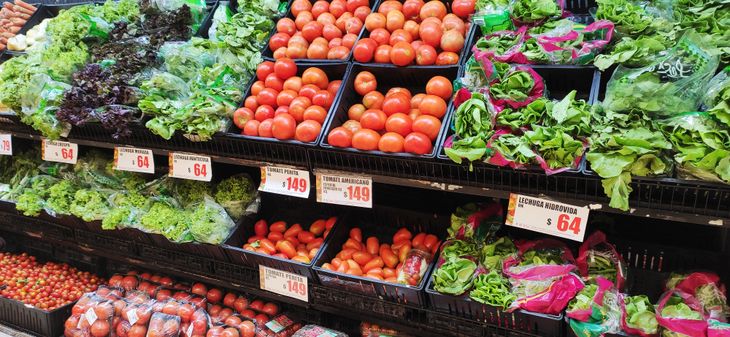The rate of inflation annual rate as of February fell to 4.7%, adding the ninth consecutive month within the target range established by the Central Bank of Uruguay (BCU), which ranges from 3 to 6%. It is the first time that inflation has remained within the range for such a long period, a significant achievement of the monetary authority, which reaffirmed that it will remain at that threshold in the next two years.
However, not everyone has the same opinion: inflation expectations -although they have also decreased- they are still clearly above the effective figure and half a point above the maximum value of the target range. Indeed, in the latest expectations survey business of inflation disclosed by the Statistics National Institute (INE), the median of business owners expects it to be 6.5% for next year; It is a decrease of half a point compared to the previous month and the first drop in expectations in several months, but it is still above the objective. Not far away appears the projection of the analysts consulted by the BCU itself, whose median inflation projection response is 6.2% for this year.
The causes of the recent decline in inflation There are several and they are interrelated. In the direct analysis of monetary policy itself, the BCU kept the interest rate at 9% in the last meeting of the Monetary Policy Committee (Copom), aiming not only to lower inflation but also expectations, which – as we saw – are resisting. This has reaffirmed the contractionary bias of monetary policy, which is clearly reflected in the inflation data.
Monetary policy, activity and competitiveness
A contractionary monetary policy – by definition – negatively affects the activity. In Uruguay, There is a certain consensus that this effect occurs mainly through the exchange channel, with a decrease in the dollar that affects the competitiveness (and with it the activity). The credit channel is considered less relevant – the monetary base of the Uruguay is small with respect to the economy -, although this may change (credit in pesos has expanded in several sectors). In any case, as the president of the BCU himself recently said, Diego Labat, The exchange channel is also part of the effect of monetary policy.
With a one-year peso interest rate of around 9% in the Monetary Regulation Bills (LRM), it becomes much more attractive to place pesos, Although there has been some increase in interest rate in dollars in the last year in the local financial market. Thus, the price of the dollar remains stable and the Real Exchange Rate low (5% year-on-year in the latest data, 17% drop in the last 2 years). For the exporters of goods and services and companies that compete with imported ones in the local market, it is a difficult scenario.
The economy has also been affected by the drought and the impact of Argentine crisis, with obvious deflationary effect on Uruguay. With the number of Uruguayans who have gone to the neighboring country in recent months – who have acquired various products and services there – there is less demand and pressure on local prices; The impact has been especially visible in the toiletry sector and pharmacy: Given the voluminous purchases abroad, it does not seem easy for the local pharmaceutical and cosmetic sector to raise prices. Something similar happens in clothing: between Argentine competition and the drop in dollar, Prices of clothing and footwear fell almost 8% in Uruguay in the last year, according to the INE.
Thus, the fight against inflation It is proving successful in the short term, although – as we said a few weeks ago – the battle continues. We must not ignore that in the struggle to lower the inflation rate, a distributive struggle is deployed, in which organized labor (unions) puts pressure, demanding the real preservation of the salary (when not increases), while some employers have the possibility of transferring the increases in salary costs to prices – in a certain proportion. But not all: those that compete abroad take international prices. (soybeans, wood, nights of hotel or services software); If sales prices go down and costs go up, they shrink or close. The tradable sectors are the first affected by the exchange delay; but in the medium term the impact is general.
WhatsApp Image 2024-03-11 at 17.26.57.jpeg
And food?
While the inflation low, many citizens do not have that perception, since they observe significant increases, month by month, week by week, in several items of regular consumption, notably food. And they are right: they have risen above the average index in recent years (graph). Food is almost 25% of the average consumption basket (reflected in the CPI); In the case of lower-income families (with more limited consumption), this weighting is logically greater.
Even so, not all foods evolved the same and there is a certain “room for maneuver”: if a product rises exceptionally, its consumption will fall (as long as there are reasonable alternatives). In the last year, baked goods rose 7% and dairy products rose 6%, but fresh meats fell 1%. Vegetables (after having risen a lot) stabilized, although with great variations between them. But fruits had an annual increase of 30%, pushing – alone – almost half a point up the CPI.
It could be argued that foods are tradable goods and that, therefore, they should arbitrate with prices external, from which it would be deduced that the accused exchange delay It is not so serious, because these tradables are rising above the CPI average. The problem – as reflected in studies of Opypa-MGAP at the time – is that the prices of fruits and vegetables behave more like non-tradables. Partly because they are perishable goods and whose cost component in the consumer price is mostly services (wholesale market, transportation, stock management, retail costs, taxes). As has been said more than once, lettuce that is sold to the public for 50 pesos, 5 pesos are paid to the producer.
But there is more: fruits and vegetables are commercially protected products in Uruguay; there is no free import, since the act of importing (which should be open, free, even with or without tariffs) is subject to the availability of health permits (called Afidis). This is a serious problem for consumers of these products, but also for the economy in general, given the incidence of fruits and vegetables in the CPI (3.6% of the total).
Fruits Vegetables Supermarket Prices Inflation

Photo: @juancacerespe
Volatility and prices
A recent study of CPA Ferrere addresses this issue and, first of all, highlights that the volatility of fruit and vegetable prices is higher than in other countries. This should not be surprising: without the possibility of open importing, supply (and prices) depends on local production, small by definition.
The valuable study elaborates a scenario of evolution of the CPI with opening of imports of fruits and vegetables from Brazil (they call it counterfactual CPI) and concludes that the average CPI in Uruguay it would have been 0.6% annually below that observed in recent years. It is a huge difference for an inflation index. And the impact of protection could be greater if the effects of price increase shocks in fruits and vegetables on readjustments in the rest of the economy were considered. Uruguay It is an economy with a lot of indexation and this situation in the farmers market aggravates the problem.
Of course (CPA Ferrere mentions it) the sector farmer It has a high social relevance and its influence on political decision makers. Once again, the dilemma arises in the face of the challenge of trade openness: protection for a sector or benefit for the whole.
It is worth mentioning that the fact that the prices of fruits and vegetables tend to behave more like non-tradables does not mean that a greater opening of markets In this sector it results in lower prices for the consumer (and surely lower inflation).
It is an example (there are others, such as fuel) where greater audacity to open markets would bring benefits; and Uruguay is capable of doing so with sufficient containment of the affected sectors in the short term.
Source: Ambito




